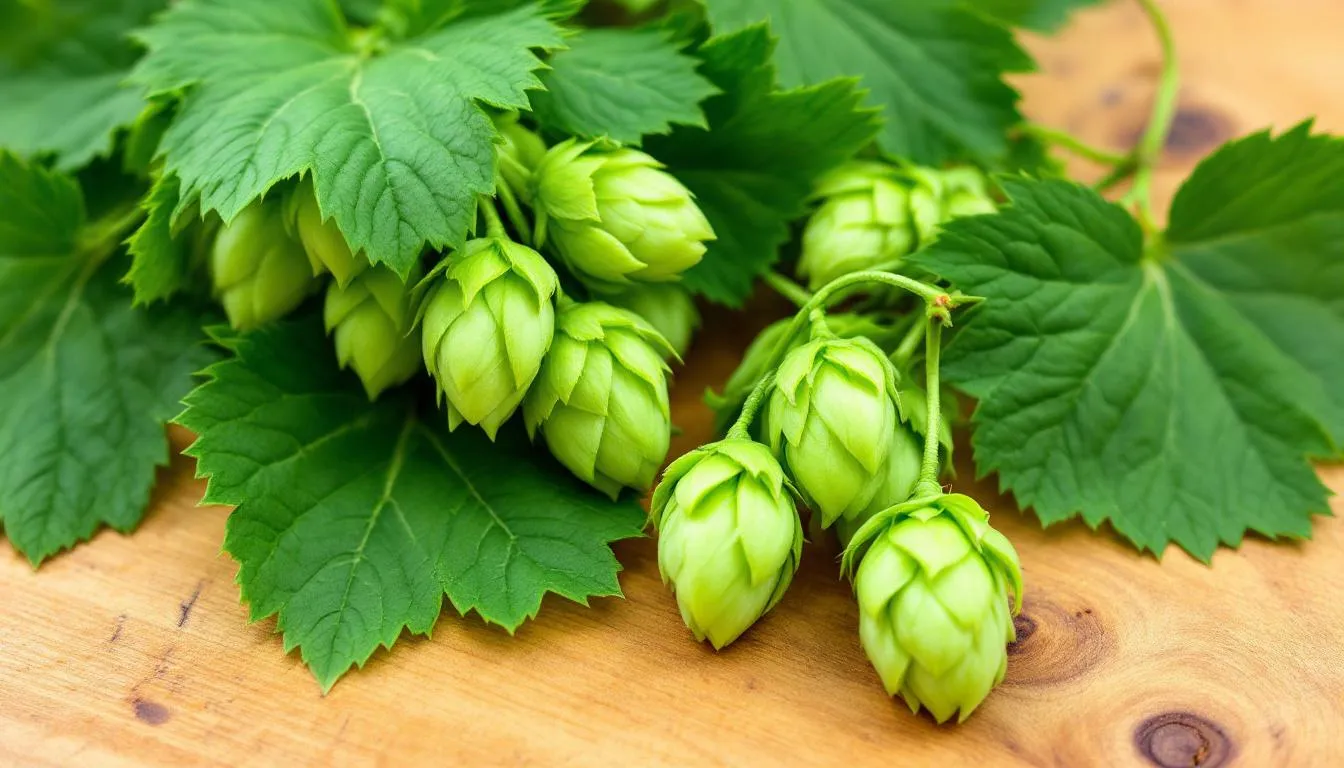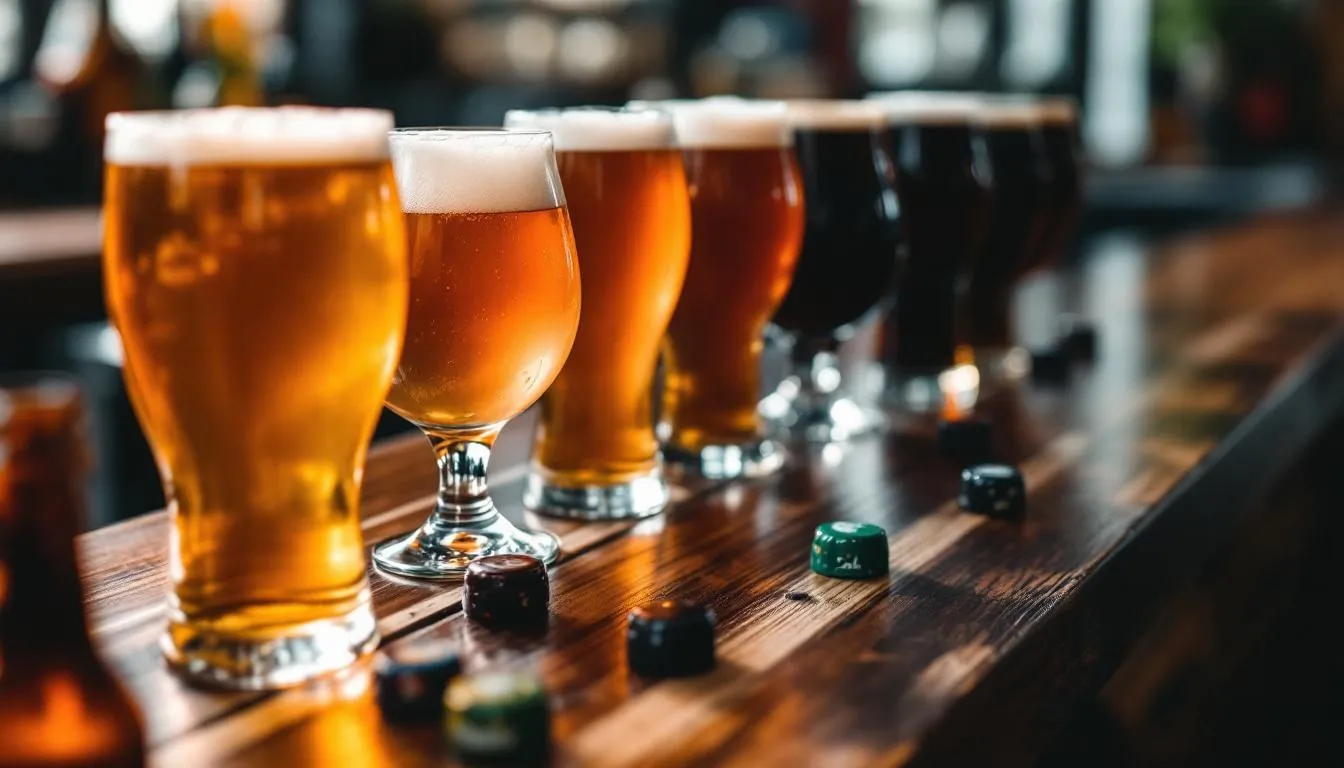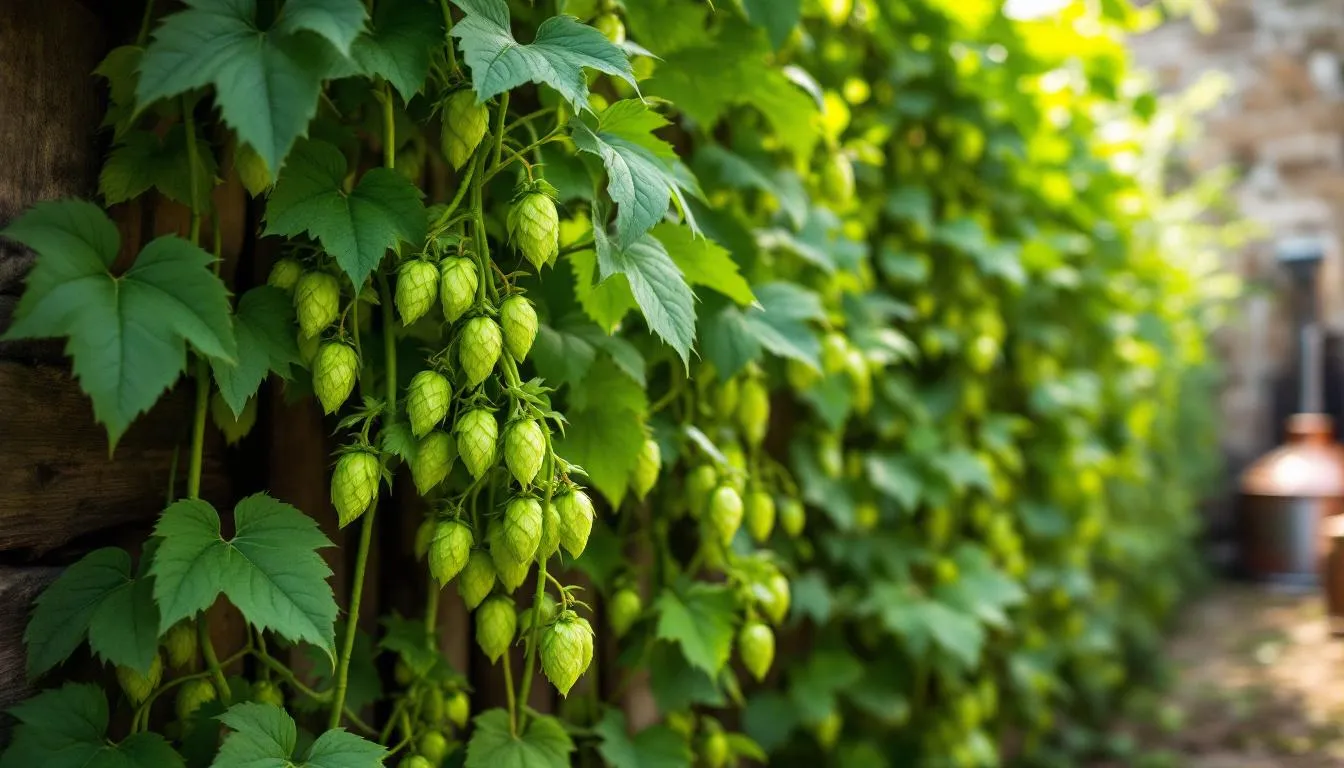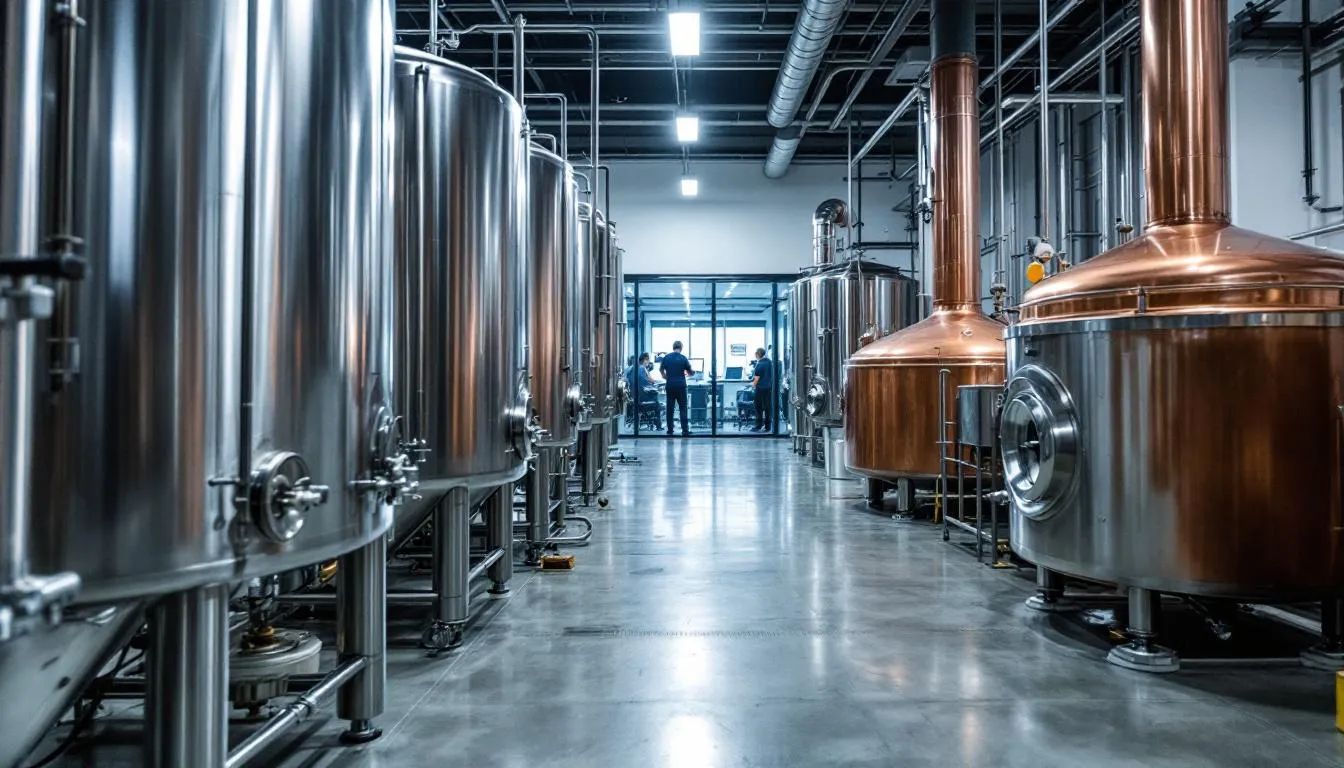IPA beer represents one of the most influential and popular styles in modern craft brewing, accounting for roughly 30-40% of all craft beer sales in the United States. What began as a practical solution for British colonial trade has evolved into a diverse family of hop-forward ales that continue to push the boundaries of brewing innovation.
From the piney, bitter West Coast classics to the juicy, hazy New England variants, India Pale Ale offers an extraordinary range of flavors, aromas, and experiences. Whether you’re new to craft beer or a seasoned enthusiast looking to deepen your understanding, this comprehensive guide will explore everything from IPA’s colonial origins to modern brewing techniques that create today’s most sought-after releases.

What is IPA Beer?
IPA stands for India Pale Ale, a distinctive beer style within the broader pale ale family that’s characterized by its prominent hop character and elevated alcohol content. Unlike regular pale ales, IPAs, showcase intense hop flavors ranging from citrus and pine to tropical fruit and floral notes, typically paired with a more assertive bitterness that balances the malt backbone.
The original India Pale Ale was brewed in England during the 1780s specifically for export to British colonies in India. The extended sea voyage lasting several months in tropical heat posed significant challenges for beer preservation. Brewers discovered that adding extra hops – which contain natural antibacterial and preservative compounds – along with higher alcohol content could help their ales survive the journey and arrive in drinkable condition.
This practical brewing solution created an entirely new flavor profile that would eventually captivate beer drinkers worldwide. The robust hopping that once served as mere preservation became the defining characteristic that modern craft brewers celebrate and continuously innovate upon.
The style experienced a remarkable revival during the American craft beer movement starting in the 1970s. Pioneering breweries like Sierra Nevada and Stone began experimenting with American hop varieties, creating distinctly different flavor profiles from their British predecessors. Today’s IPAs typically range from 5.9% to 9% ABV, though some double and triple variations can exceed 10%.
Modern IPA encompasses numerous substyles, each with unique characteristics influenced by regional brewing traditions, hop varieties, and innovative techniques. What unites all IPAs is their hop-forward nature – these are beers where hops take center stage, creating complex aromatics and flavors that can range from aggressively bitter to surprisingly smooth and juicy.
History and Origins of IPA
The story of India Pale Ale begins in the British Empire during the late 18th century, when the East India Company controlled vast territories across the Indian subcontinent. British personnel stationed in India craved familiar comforts from home, including beer, but traditional English ales couldn’t survive the arduous sea voyage around the Cape of Good Hope.
Burton-upon-Trent, a brewing center in Staffordshire, England, emerged as the epicenter of early IPA production. The town’s mineral-rich water, high in sulfates, proved ideal for brewing hoppy beers that showcased English hop varieties like Fuggle and East Kent Goldings. Brewers like Hodgson’s and later Bass developed recipes that could withstand the months-long journey to India while maintaining drinkability upon arrival.
The original Burton IPAs featured English barley malts and traditional hop varieties, creating beers with earthy, herbal, and subtly fruity characteristics. These ales were notably more bitter and alcoholic than standard English beers of the time, with ABV levels often reaching 6-7% compared to the typical 4-5% of domestic ales.
By the mid-19th century, IPA had become enormously popular not just in India but back in Britain as well. However, the style’s dominance began to wane in the early 20th century as consumer preferences shifted toward lighter lagers and milder ales. Two world wars, economic hardship, and changing tastes nearly eliminated traditional IPA from British brewing.
The American craft beer revolution of the 1970s and 1980s sparked IPA’s renaissance. Pioneering brewers like Ken Grossman of Sierra Nevada and Steve Wagner of Stone Brewing began experimenting with American hop varieties, creating entirely new flavor profiles that emphasized citrus, pine, and tropical fruit characteristics. This marked the beginning of IPA’s transformation from a historical curiosity into the driving force of modern craft brewing.
The timeline from the 1780s to present day shows remarkable evolution: from British colonial necessity to near extinction, then rebirth as America’s most innovative and popular craft beer style. Today, IPA continues evolving with new hop varieties, brewing techniques, and creative interpretations that would amaze those original Burton brewers.
Main IPA Styles and Substyles
The IPA category has expanded dramatically from its British origins, now encompassing numerous distinct substyles that reflect regional brewing traditions, available ingredients, and evolving consumer preferences. Modern classification systems recognize at least nine primary IPA variations, each with characteristic flavor profiles, appearance, and brewing techniques.
Regional influences have played a crucial role in IPA development, with different areas emphasizing unique hop varieties and brewing philosophies. American IPAs typically showcase New World hops with intense citrus and tropical fruit characteristics, while European versions often maintain more traditional earthy and floral profiles. Strength ranges vary significantly, from session IPAs around 3-5% ABV designed for extended drinking, to imperial versions exceeding 10% ABV that deliver intense hop and alcohol character.
Understanding these major categories provides the foundation for appreciating IPA’s remarkable diversity and choosing styles that match your flavor preferences. Each substyle represents years of brewing innovation and regional interpretation, creating a rich tapestry of hop-forward experiences.
West Coast IPA
West Coast IPA originated in California during the late 1970s and sparked the American craft beer revolution that continues today. This style emerged from pioneering breweries like Sierra Nevada, Stone, and Russian River, who began experimenting with American hop varieties that produced dramatically different flavors from traditional English hops.
The defining characteristics of West Coast IPA include crystal-clear to lightly hazy appearance, assertive bitterness that hits immediately on the palate, and dry finish that leaves you craving another sip. These beers typically range from 5.9% to 7.9% ABV, with IBU levels often exceeding 60-80 units to create that signature West Coast bite.
Classic American hops like Cascade, Centennial, Simcoe, Amarillo, and Citra dominate West Coast recipes, delivering intense citrus and pine aromas that became synonymous with American craft brewing. Cascade hops, in particular, provided the grapefruit and floral notes that defined early American IPAs and influenced countless brewers worldwide.
The flavor profile emphasizes citrus notes ranging from grapefruit and orange to lemon zest, combined with resinous pine character that creates a clean, crisp drinking experience. The dry finish results from highly attenuative yeast strains and restrained use of specialty malts, allowing hop character to shine without interference from residual sweetness.
Notable examples include Russian River’s Pliny the Elder, widely considered the gold standard for West Coast IPA, and Stone IPA, which helped establish the style’s commercial viability. These beers demonstrate the balanced drinkability that made West Coast IPA accessible to mainstream audiences while maintaining the bold hop character that craft beer enthusiasts demanded.

New England IPA (NEIPA)
New England IPA represents one of the most significant innovations in modern brewing, developing primarily in Vermont, Maine, and Massachusetts breweries during the 2010s. This style revolutionized IPA by prioritizing hop aromatics over bitterness while creating an entirely new visual and textural experience through deliberate haze.
The key features that distinguish NEIPA include its characteristic cloudy appearance, intensely juicy fruit flavors, and remarkably soft mouthfeel that contrasts sharply with West Coast IPA’s aggressive dryness. Brewers achieve this texture through generous additions of oats and wheat, which contribute proteins and beta-glucans that create the style’s signature smoothness.
Modern hop varieties like Mosaic, Galaxy, El Dorado, and Citra play starring roles in NEIPA recipes, delivering explosive tropical fruit aromatics reminiscent of mango, passion fruit, pineapple, and citrus. These hops are typically added late in the brewing process or during fermentation through dry hopping techniques that maximize aroma extraction while minimizing harsh bitterness.
Lower bitterness levels, often 30-50 IBU compared to West Coast IPA’s 60-80+ IBU, allow the intense hop aromatics to dominate the flavor experience. The emphasis shifts from bitter balance to aromatic intensity, creating beers that taste almost like fresh fruit juice while maintaining clear beer character and moderate alcohol strength.
The Alchemist’s Heady Topper, brewed in Vermont, is widely credited with popularizing the NEIPA style and inspiring countless imitators. Lawson’s Finest Liquids Sip of Sunshine represents another benchmark example, showcasing the style’s ability to deliver massive hop flavor without overwhelming bitterness.
NEIPA’s rapid popularity transformed the craft beer landscape, with hazy IPAs representing roughly 20% of all craft beer draft sales by 2022. The style continues evolving with new hop varieties and techniques that push the boundaries of fruit-forward beer flavors.
Double IPA (DIPA)
Double IPA, also called Imperial IPA, takes the hop-forward concept to its logical extreme by roughly doubling both the hop content and malt backbone compared to standard IPAs. These powerful beers typically range from 7.5% to 9.9% ABV, with some exceptional examples reaching even higher alcohol levels.
The “double” designation refers not just to strength but to intensity across all flavor components. Brewers use significantly more hops throughout the brewing process, from bittering additions during the boil to massive dry hop charges that can exceed five pounds per barrel. This creates layers of hop character that unfold as the beer warms and evolves in the glass.
Double IPAs can embrace either West Coast or New England style characteristics, with clear, bitter West Coast versions emphasizing pine and citrus alongside alcohol warmth, while hazy DIPA versions focus on tropical fruit aromatics with smoother alcohol integration. The challenge lies in balancing the increased alcohol strength with hop intensity without creating overwhelming sweetness or harsh alcohol burn.
Russian River’s Pliny the Elder remains the most celebrated West Coast DIPA, demonstrating how proper balance allows both hop character and alcohol strength to complement rather than compete. On the hazy side, breweries like Cloudwater have created DIPA versions of their popular Crystallography series that showcase intense tropical fruit flavors alongside elevated strength.
Brewing considerations for DIPA include managing fermentation temperatures to minimize hot alcohol character, using appropriate yeast strains that can handle higher alcohol environments, and timing hop additions to maximize flavor extraction while maintaining balance. The increased malt bill required for higher alcohol can add subtle sweetness that either complements or conflicts with hop character depending on execution.
Session IPA
Session IPA represents brewing ingenuity in creating lower alcohol versions that maintain hop character while reducing alcohol content to typically 3-5% ABV. The term “session” refers to the British tradition of extended drinking sessions where lower alcohol beers allowed for prolonged consumption without excessive intoxication.
The challenge of Session IPA lies in preserving the aromatic intensity and hop flavor that defines IPA while working with reduced malt bills that limit alcohol production. Brewers achieve this through careful hop selection, emphasizing late additions and dry hopping techniques that maximize aroma without contributing excessive bitterness.
Maintaining hop character requires different techniques compared to standard IPAs. Lower alcohol levels mean less malt sweetness to balance hop bitterness, so brewers must restrain bittering hop additions while amplifying aromatic compounds through strategic timing and hop variety selection.
Some craft beer purists debate whether Session IPA qualifies as authentic IPA, arguing that the reduced alcohol content fundamentally changes the beer’s character. However, the style has gained popularity among health-conscious consumers and those seeking lower calorie craft beer options without sacrificing flavor complexity.
The style works particularly well for day drinking, outdoor activities, or situations where you want craft beer flavor without full-strength alcohol impact. Popular examples demonstrate that skillful brewing can create satisfying hop character even within session strength parameters.
Regional and International IPA Variations
As IPA spread beyond its British origins and American renaissance, different regions adapted the style to showcase local ingredients, brewing traditions, and cultural preferences. These regional interpretations demonstrate IPA’s flexibility as a brewing template while highlighting how terroir influences beer flavor just as it does wine.
International hop varieties have become increasingly important in creating distinctive regional character. European hops tend toward earthy, spicy, and subtly fruity profiles, while Southern Hemisphere varieties often contribute unique tropical and white wine-like characteristics. Asian hop breeding programs have introduced entirely new flavor compounds that continue expanding IPA’s aromatic palette.
Understanding these regional variations helps appreciate how local ingredients and brewing philosophies shape beer character, creating distinct expressions of the hop-forward IPA concept that reflect their geographic origins.
English IPA
Traditional English IPA maintains the closest connection to the style’s colonial origins, typically brewed with classic British ingredients and time-honored techniques developed in Burton-upon-Trent. These beers showcase English base malts like Maris Otter, which contributes biscuity, slightly sweet character that provides an excellent foundation for hop character.
English hop varieties create distinctly different flavor profiles compared to their American counterparts. Fuggle and East Kent Goldings, the traditional varieties used in original IPAs, deliver herbaceous, earthy, and gently fruity characteristics with subtle floral notes. These hops create complexity through restraint rather than aggressive intensity.
The brewing water in Burton-upon-Trent, high in sulfates and low in carbonates, naturally enhances hop character while creating a dry, crisp finish that became the template for English IPA. Modern English brewers often adjust their water chemistry to replicate these mineral profiles even when brewing in different locations.
Examples like Fuller’s Bengal Lancer and Harvey’s Elizabethan Ale demonstrate traditional English IPA character, typically featuring 5-6% ABV with balanced bitterness that supports rather than dominates the overall flavor profile. These beers influenced the American craft brewing renaissance when pioneering brewers studied traditional recipes and techniques.
English IPA’s influence extends far beyond historical significance. The balanced approach to hop character, emphasis on drinkability, and integration of malt sweetness continue inspiring modern brewers seeking alternatives to extremely hop-forward American styles.
Belgian IPA
Belgian IPA represents a fascinating fusion of Belgium’s renowned fermentation expertise with hop-forward brewing principles. Belgian brewers approach IPA through their traditional lens of complex yeast character, creating beers that emphasize fruity esters and spicy phenols alongside hop aromatics.
The key difference lies in yeast selection and fermentation management. Belgian yeast strains produce distinctive fruity esters reminiscent of banana, apple, and pear, plus spicy phenolic compounds that add complexity. These fermentation byproducts interact with hop flavors in unique ways, creating layered complexity that differs markedly from clean American fermentation profiles.
Belgian IPAs often finish drier than their American counterparts due to higher attenuation rates typical of Belgian yeast strains. This dryness allows hop character to express more clearly while the yeast-derived flavors add complementary rather than competing elements.
The muted hop profile compared to American IPAs reflects Belgian brewing philosophy that prizes balance and complexity over single-flavor dominance. Hop character provides structure and aromatics while yeast character contributes the beer’s distinctive personality.
Notable examples include Stone Cali-Belgique IPA and Duvel Tripel Hop, which demonstrate how Belgian brewing techniques can create compelling interpretations of hop-forward beer styles. These beers appeal to drinkers seeking IPA character with European sophistication and complexity.

New Zealand IPA
New Zealand IPA showcases unique Southern Hemisphere hop varieties that create distinctly different flavor profiles from American or European hops. The country’s hop breeding programs have developed varieties that contribute herbal, vinous, and white grape characteristics alongside tropical fruit notes.
The flavor profile often emphasizes herbal and wine-like characteristics that reflect New Zealand’s viticultural expertise. Hops like Nelson Sauvin deliver Sauvignon Blanc-like notes of gooseberry and passion fruit, while varieties like Motueka contribute lime and tropical fruit character with distinctive herbal undertones.
New Zealand’s isolation allowed hop breeding programs to develop varieties that express unique terroir characteristics. The maritime climate and volcanic soils contribute to hop flavors that differ markedly from those grown in traditional hop regions like the Pacific Northwest or Europe.
Examples like Garage Project’s Pernicious Weed and 8 Wired’s Hopwired demonstrate how New Zealand hops can create compelling IPAs that taste distinctly different from American versions while maintaining the hop-forward character that defines the style.
The distinctive taste profile appeals to drinkers seeking new flavor experiences within the IPA category. New Zealand IPAs often provide excellent alternatives for those who find American hop varieties too aggressive or one-dimensional.
Specialty and Modern IPA Innovations
Contemporary brewers continue pushing IPA boundaries through experimental ingredients, unconventional techniques, and creative interpretations that challenge traditional style definitions. These innovations reflect both brewing creativity and evolving consumer preferences for unique flavor experiences.
Modern specialty IPAs often incorporate elements from other beer styles, creating hybrid categories that expand IPA’s definition. Fruit additions, bacterial fermentation, unusual adjuncts, and innovative hopping techniques create new subcategories that may eventually become recognized styles in their own right.
The experimental nature of specialty IPAs makes them popular vehicles for limited releases and brewery showcases, allowing brewers to test new concepts while maintaining the hop-forward character that IPA enthusiasts expect.
Hazy and Milkshake IPAs
Hazy IPAs, including the New England substyle discussed earlier, focus on maximizing tropical fruit flavors while creating smooth, approachable mouthfeel through deliberate haze formation. While these beers differ markedly from traditional British beer styles in both appearance and flavor, both approaches showcase the diversity and creativity in brewing today. The haze results from specific brewing techniques including high-protein adjuncts, particular yeast strains, and extensive dry hopping that creates suspended particles.
Milkshake IPAs take the concept further by incorporating lactose (milk sugar) that adds sweetness and creamy body reminiscent of fruit milkshakes. Some versions include actual fruit purees or other dairy-inspired ingredients that enhance the dessert-like character.
The techniques for creating haze include using oats, wheat, and specific yeast strains that don’t flocculate well, leaving suspended proteins and yeast cells that create the characteristic cloudy appearance. Dry hopping during active fermentation allows hop oils to bind with yeast cells, creating stable haze that doesn’t settle out.
Examples like Northern Monk’s Make it Happen and WeldWerks’ Double Peach Milkshake IPA demonstrate how these techniques can create beers that taste more like fruit smoothies than traditional beer while maintaining recognizable IPA character.
The popularity of hazy and milkshake IPAs reflects consumer demand for approachable, fruit-forward flavors that provide IPA complexity without aggressive bitterness. These styles often appeal to drinkers who previously avoided IPAs due to perceived harshness.
Fruit and Sour IPAs
Fruited IPAs incorporate whole fruit, fruit purees, or natural fruit extracts to enhance and complement hop flavors. The fruit additions can range from subtle enhancements that support hop character to bold additions that create entirely new flavor profiles.
Sour IPAs use bacterial fermentation, typically with Lactobacillus, to create tart acidity that balances hop bitterness while adding refreshing character. The sourness often enhances fruit flavors while providing a crisp, clean finish that differs markedly from traditional IPA profiles.
The brewing process for fruit IPAs requires careful timing to preserve fresh fruit character while ensuring proper fermentation and stability. Fruit additions during secondary fermentation or conditioning typically provide the best flavor retention without creating fermentation issues.
Popular examples include Ballast Point’s Grapefruit Sculpin, which demonstrates how citrus additions can enhance existing hop character, and Buxton’s Trolltunga, which showcases how fruit and sourness can create complex, refreshing interpretations of hop-forward brewing.
These specialty styles appeal to drinkers seeking familiar IPA elements with enhanced fruit character or refreshing acidity. They often work well as warm-weather beers or alternatives for those who find traditional IPAs too intense.
Black and Specialty Color IPAs
Black IPA, also called Cascadian Dark Ale, combines dark malts with hop character and bitterness, creating visually striking beers that challenge expectations about IPA appearance. The dark malts contribute roasted, chocolate, or coffee notes that complement rather than mask hop character.
Red and Brown IPAs feature caramel and toffee notes from specialty malts alongside citrus and pine hop characteristics. These styles demonstrate how malt character can enhance rather than compete with hop flavors when properly balanced.
White IPA blends wheat beer characteristics with IPA hopping, often using traditional witbier spices like coriander and orange peel alongside modern hop varieties. The result combines the refreshing character of wheat beer with hop-forward intensity.
Examples like Thornbridge’s Wild Raven (Black IPA) and Firestone Walker’s Wookey Jack demonstrate how creative malt bills can create unique expressions of hop-forward brewing while maintaining clear IPA identity.
The success of colored IPAs proves that hop character can work successfully with diverse malt profiles, expanding IPA’s possibilities beyond the pale ale foundation that originally defined the style.
IPA Brewing Process and Techniques
Brewing exceptional IPA requires understanding how hop timing, selection, and usage interact with malt character, yeast performance, and water chemistry to create balanced, flavorful beer. The brewing process for IPA differs significantly from other styles due to the emphasis on extracting maximum hop character while maintaining drinkability.
Modern IPA brewing incorporates techniques that would have been impossible or unknown to original British brewers. Contemporary hopping methods, new hop products, and advanced understanding of hop chemistry allow today’s brewers to create intensities and flavor profiles that push far beyond traditional boundaries.
Success in IPA brewing requires balancing multiple variables simultaneously: hop bitterness must complement malt sweetness, alcohol strength should enhance rather than overshadow hop character, and the overall beer must remain approachable despite intense flavors.
Hop Selection and Usage
Different hop varieties contribute distinct flavor and aroma characteristics that define IPA substyles. American hops like Cascade, Citra, and Mosaic provide citrus and tropical fruit notes, while European varieties offer more subtle earthy and floral character. Southern Hemisphere hops contribute unique wine-like and herbal characteristics.
The timing of hop additions critically affects final beer character. Bittering hops added early in the boil contribute primarily bitterness through alpha acid isomerization, while aroma hops added late in the boil or during fermentation provide volatile aromatics with minimal bitterness contribution.
Modern techniques include Cryo hops (concentrated lupulin powder), hop extracts for precise bittering control, and Double Dry Hopped (DDH) methods that use massive dry hop charges to create intense aromatics. These innovations allow brewers to achieve hop intensities impossible through traditional methods. Another innovation in modern brewing includes the use of fruit additions to create unique flavor profiles, further expanding the diversity of beer styles.
Regional hop preferences reflect both availability and cultural brewing traditions. American IPAs emphasize New World varieties with aggressive fruit and citrus character, while European brewers often prefer traditional varieties that provide complexity through subtlety rather than intensity.
Dry hopping techniques have become increasingly sophisticated, with brewers experimenting with timing, temperature, and contact duration to optimize extraction while minimizing harsh or astringent flavors. Some brewers add dry hops during active fermentation to create biotransformation effects that unlock additional aromatic compounds.
Malt Bill and Balance
Base malts provide the fermentable sugar foundation that supports hop character while contributing underlying flavor. Two-row and Pilsner malts offer clean, neutral character that allows hops to dominate, while specialty malts like Maris Otter add subtle biscuit and honey notes that can complement hop flavors.
Specialty malts serve different functions depending on IPA substyle. Wheat and oats contribute proteins and beta-glucans that create the smooth mouthfeel essential for hazy IPAs, while crystal malts add caramel sweetness that can balance aggressive hop bitterness in West Coast styles.
Avoiding excessive sweetness while maintaining adequate body requires careful attention to malt selection and processing. High attenuation creates the dry finish that characterizes many IPA styles, but too much dryness can make hop bitterness seem harsh and unbalanced.
Achieving proper attenuation involves yeast selection, fermentation temperature control, and mash temperature optimization. Lower mash temperatures create more fermentable sugars that lead to drier finishes, while higher temperatures leave more residual sweetness that can balance hop character.
The grain bill must support the intended alcohol level while providing appropriate mouthfeel and flavor balance. Double IPAs require significantly more base malt to achieve target alcohol levels, which can add sweetness that either complements or conflicts with hop character depending on execution.

Popular IPA Brands and Examples
Understanding IPA styles becomes clearer through specific commercial examples that demonstrate each category’s characteristics. These benchmark beers have defined styles, influenced countless imitators, and continue setting standards for quality and authenticity within their respective categories.
The craft beer market offers hundreds of excellent IPA options, from widely distributed national brands to limited local releases. These examples represent accessible options that showcase classic style characteristics while demonstrating the quality levels that define exceptional IPA brewing.
West Coast IPA Examples:
- Russian River Pliny the Elder: Widely considered the gold standard for West Coast IPA, featuring perfect balance between hop intensity and drinkability
- Stone IPA: A commercial pioneer that helped establish the style’s mainstream appeal
- Sierra Nevada Celebration: An early hop-forward ale that influenced American craft brewing
- Ballast Point Sculpin IPA: Demonstrates modern West Coast character with tropical fruit notes
New England IPA Examples:
- The Alchemist Heady Topper: The beer that popularized the hazy IPA movement
- Lawson’s Finest Liquids Sip of Sunshine: Showcases intense tropical fruit character
- Tree House Julius: Represents the pinnacle of NEIPA brewing technique
- Other Half Green Diamonds: Demonstrates how NYC brewers interpreted the New England style
Double IPA Examples:
- Dogfish Head 90 Minute IPA: An early standard-bearer for the imperial style
- Russian River Pliny the Younger: Limited annual release that creates nationwide excitement
- Stone Ruination IPA: Aggressive West Coast DIPA that influenced countless imitators
- The Kernel Export India Porter: London brewery’s unique take on imperial strength
Session IPA Examples:
- Founder’s All Day IPA: Demonstrates how to maintain hop character in session strength
- Stone Go To IPA: Accessible introduction to hop-forward flavors
- Lagunitas DayTime IPA: Crisp, refreshing take on session brewing
Specialty IPA Examples:
- Ballast Point Grapefruit Sculpin: Fruit IPA that enhances rather than masks hop character
- Firestone Walker Wookey Jack: Black IPA that balances roasted malt with hop intensity
- New Belgium Voodoo Ranger Juicy Haze: Widely available hazy IPA that showcases the style
These examples provide starting points for exploring different IPA styles and understanding how various breweries interpret hop-forward brewing. Availability varies by region, but most demonstrate the quality and character that define their respective categories.
Serving and Pairing IPA Beer
Proper serving technique maximizes IPA’s hop character while ensuring optimal flavor development and aromatics. Unlike many beer styles that benefit from cellar temperature service, IPAs perform best when served slightly warmer than typical lager service temperatures.
The optimal serving temperature ranges from 45-50°F (7-10°C), which allows hop aromatics to express fully while maintaining refreshing character. Serving too cold suppresses volatile hop compounds that create IPA’s signature aromatics, while serving too warm can emphasize alcohol and make bitterness seem harsh.
Glassware selection affects both aroma concentration and visual presentation. Tulip glasses, IPA-specific glasses, or wine glasses work well by concentrating aromatics near the nose while providing adequate surface area for proper carbonation release. Avoid frosted glasses, which suppress aromatics and dilute flavors.
Food Pairing Suggestions:
For specific pairing ideas, check out this review of Little Wild IPA from The Little Beer Corporation, which discusses its flavor profile and potential matches.
IPAs pair exceptionally well with bold, flavorful foods that complement rather than compete with hop character:
- Spicy foods: The hop bitterness and carbonation help cool palate burn from chili peppers and hot spices
- Grilled meats: Charred flavors complement hop bitterness while fat content balances intensity
- Strong cheeses: Aged cheddar, blue cheese, and other intense cheeses create excellent flavor combinations
- Indian and Thai cuisine: Traditional pairing that reflects IPA’s colonial origins
- Citrus-based dishes: Natural complement to citrusy American hop varieties
Storage Considerations:
IPA freshness significantly impacts flavor quality, as hop aromatics degrade quickly through oxidation and light exposure. Store IPAs in refrigerated conditions away from light, and consume as fresh as possible – ideally within 30-60 days of packaging for optimal flavor.
Unlike barrel-aged stouts or Belgian ales that can improve with age, IPAs generally deteriorate over time as hop aromatics fade and develop stale, grassy, or papery off-flavors. Check packaging dates when purchasing and prioritize recently produced examples.
The ideal consumption timeline emphasizes immediate enjoyment of hop-forward character at peak intensity. Some drinkers enjoy tracking how IPA flavors change over time, but these changes typically represent degradation rather than improvement.
Proper storage and serving technique allows IPA’s complex hop character to shine, creating the optimal drinking experience that showcases the brewer’s intended flavor profile and aromatic intensity.
Conclusion
IPA beer has evolved from a practical solution for British colonial trade into the most innovative and popular category in modern craft brewing. From the original Burton-upon-Trent ales to today’s hazy New England variants and experimental fruit additions, India Pale Ale continues pushing boundaries while honoring its hop-forward heritage.
The diversity within the IPA category ensures options for every palate, whether you prefer the aggressive bitterness of West Coast classics, the smooth tropical fruit character of hazy variants, or the intense complexity of double strength versions. Regional interpretations from England, Belgium, and New Zealand demonstrate how local ingredients and brewing traditions create unique expressions of hop-forward brewing.
Understanding IPA’s history, styles, and brewing techniques enhances appreciation for this remarkable beer category that dominates craft beer sales and continues driving innovation. Whether you’re just discovering craft beer or expanding your hop knowledge, the world of IPA offers endless opportunities for exploration and enjoyment.
Start your IPA journey with accessible examples like Sierra Nevada Celebration or Stone IPA, then explore regional variations and specialty styles as your palate develops. The best way to understand IPA’s diversity is through direct experience – each style offers unique pleasures that reflect brewing creativity and hop variety innovation.
As IPA continues evolving with new hop varieties, brewing techniques, and creative interpretations, one constant remains: the celebration of hop character that transforms simple ingredients into complex, aromatic experiences that capture the imagination and satisfy the palate.

Leave a Reply